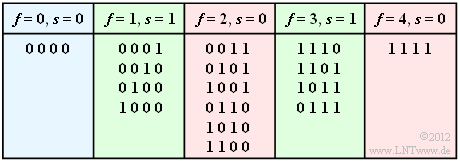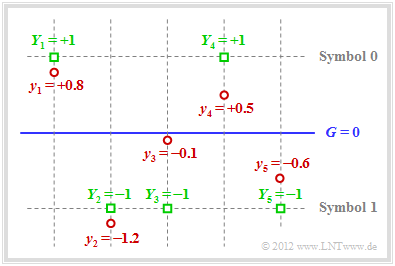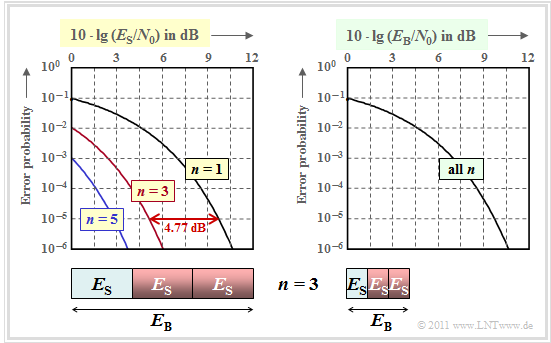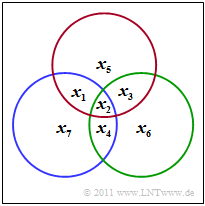Single Parity-check Codes
The »Single parity-check code« $\rm (SPC)$ adds to the information block $\underline{u}= (u_1, u_2, \hspace{0.05cm}\text{...}\hspace{0.05cm}, u_k)$ a parity bit $p$:
- $$\underline{u} = (u_1, u_2,\hspace{0.05cm} \text{...} \hspace{0.05cm} , u_k) \hspace{0.3cm}$$
- $$\Rightarrow \hspace{0.3cm} \underline{x} = (x_1, x_2,\hspace{0.05cm}\text{...} \hspace{0.05cm} , x_n) = (u_1, u_2,\hspace{0.05cm} \text{...}\hspace{0.05cm} , u_k, p) \hspace{0.05cm}.$$
The graphic shows three coding examples:
- $|\hspace{0.05cm}\mathcal{C}\hspace{0.05cm}| = 4 \hspace{0.15cm} (k = 2)$,
- $|\hspace{0.05cm}\mathcal{C}\hspace{0.05cm}| = 8 \hspace{0.15cm} (k = 3)$,
- $|\hspace{0.05cm}\mathcal{C}\hspace{0.05cm}| = 16 \hspace{0.15cm} (k = 4)$.
This very simple code can be characterized as follows:
- From $n = k + 1$ follows for the »code rate« $R = k/n = (n-1)/n$ and for the »redundancy« $1-R = 1/n$. For $k = 2$, for example, the code rate is $2/3$ and the relative redundancy is $33.3\%$.
- The parity bit is obtained by »modulo–2« addition. This is the addition in the $\text{Galois field}$ to the base $2$ ⇒ $\rm GF(2)$, so that $1 \oplus 1 = 0$ results:
- \[p = u_1 \oplus u_2 \oplus \text{...} \hspace{0.05cm} \oplus u_k \hspace{0.05cm}.\]
- Thus every valid code word $\underline{x}$ contains an even number of ones. Expressed as $\oplus$ or in simplified notation according to the second equation, this condition reads:
- \[ x_1 \oplus x_2 \oplus \text{...} \hspace{0.05cm} \oplus x_n = 0 \hspace{0.05cm}, \hspace{0.5cm}{\rm or:}\hspace{0.5cm} \sum_{i=1}^{n} \hspace{0.2cm} x_i = 0\hspace{0.05cm} , \hspace{0.3cm} {\rm addition\hspace{0.15cm} in \hspace{0.15cm} GF(2)} \hspace{0.05cm}. \]
- For $k = 2$ ⇒ $n = 3$ the following four code words result, where the parity bit $p$ is marked by a small arrow in each case:
- \[\underline{x}_0 = (0, 0_{\hspace{0.05cm} \rightarrow}\hspace{0.05cm} 0)\hspace{0.05cm}, \hspace{0.2cm} \underline{x}_1 = (0, 1_{\hspace{0.05cm} \rightarrow}\hspace{0.05cm} 1)\hspace{0.05cm}, \hspace{0.2cm} \underline{x}_2 = (1, 0 _{\hspace{0.05cm} \rightarrow}\hspace{0.05cm} 1)\hspace{0.05cm}, \hspace{0.2cm} \underline{x}_3 = (1, 1 _{\hspace{0.05cm} \rightarrow}\hspace{0.05cm} 0)\hspace{0.05cm}.\]
- This code $\mathcal{C} = \big \{ (0, 0, 0), \ (0, 1, 1), \ (1, 0, 1), \ (1, 1, 0) \big \}$ is »linear« since the sum of any two code words again gives a valid code word, for example:
- $$\underline{x}_1 \oplus \underline{x}_2 = \underline{x}_3.$$
- For any $k$ ⇒ $n = k+1$ each code word differs from all others at an even number of positions. Thus, the minimum distance of the code is
- $$d_{\rm min} = 2.$$
$\text{Definition:}$ Each $\text{single parity-check code (SPC)}$ can be formally described as follows:
- \[\mathcal{C} = \{ \underline{x} \in {\rm GF}(2^n)\hspace{-0.15cm}: \hspace{0.15cm}{\rm with \hspace{0.15cm}even\hspace{0.15cm} number\hspace{0.15cm} of\hspace{0.15cm} ones\hspace{0.15cm} in \hspace{0.15cm} } \underline{x} \}\hspace{0.05cm}.\]
- With the general code name $(n, \ k, \ d_{\rm min})$ any single parity–check code can also be named $\text{SPC }(n, \ n-1, \ 2)$ .
- The top graph thus shows the $\text{SPC (3, 2, 2)}$, the $\text{SPC (4, 3, 2)}$, and the $\text{SPC (5, 4, 2)}$.
The digital channel may change the code word $\underline{x}= (x_1, x_2, \hspace{0.05cm}\text{...}\hspace{0.05cm}, x_n)$ to the received word $\underline{y}= (y_1, y_2, \hspace{0.05cm}\text{...}\hspace{0.05cm}, y_n)$. With the error vector $\underline{e}= (e_1, e_2, \hspace{0.05cm}\text{...}\hspace{0.05cm}, e_n)$ holds:
- $$\underline{y}= \underline{x} \oplus \underline{e}.$$
For $\text{decoding the single parity-check code}$ one forms the so-called »syndrome«:
- \[s = y_1 \oplus y_2 \oplus \hspace{0.05cm}\text{...} \hspace{0.05cm} \oplus y_n = \sum_{i=1}^{n} \hspace{0.2cm} y_i \hspace{0.1cm} \in \hspace{0.2cm} \{0, 1 \} \hspace{0.05cm}.\]
The result $s=1$ then indicates (at least) one bit error within the code word, while $s=0$ should be interpreted as follows:
- The transmission was error-free, or:
- the number of bit errors is even.
$\text{Example 1:}$ We consider the $\text{SPC (4, 3, 2)}$ and assume that the all-zero word was sent. The table shows all possibilities that $f$ bits are corrupted KORREKTUR: falsified and gives the respective syndrome $s \in \{0, 1\}$.
For the $\text{BSC model}$ with the crossover probability $\varepsilon = 1\%$ the following probabilities then result:
- The information word is correctly decoded (blue background):
- \[{\rm Pr}(\underline{v} = \underline{u}) = {\rm Pr}(\underline{y} = \underline{x}) = (1 - \varepsilon)^n = 0.99^4 \approx 96\,\%\hspace{0.05cm}.\]
- The decoder detects that transmission errors have occurred (green background):
- $${\rm Pr}(s=1) \hspace{-0.1cm} = \hspace{-0.1cm} \sum_{f=1 \atop f \hspace{0.1cm}{\rm odd} }^{n} {n \choose f} \cdot \varepsilon^{f} \cdot (1 - \varepsilon)^{n-f}$$
- $$\Rightarrow \hspace{0.3cm} {\rm Pr}(s=1) \hspace{-0.1cm} = {4 \choose 1} \cdot 0.01 \cdot 0.99^3 + {4 \choose 3} \cdot 0.01^3 \cdot 0.99 \approx 3.9\,\%\hspace{0.05cm}.$$
- The information word is decoded incorrectly (red background):
- \[{\rm Pr}(\underline{v} \ne \underline{u}) \hspace{-0.1cm} = \hspace{-0.1cm} \sum_{f=2 \atop f \hspace{0.1cm}{\rm gerade} }^{n} {n \choose f} \cdot \varepsilon^{f} \cdot (1 - \varepsilon)^{n-f} = 1 - {\rm Pr}(\underline{v} = \underline{u}) - {\rm Pr}(s=1)\approx 0.1\,\%\hspace{0.05cm}.\]
We refer here to the HTML5/JavaScript applet $\text{Binomial and Poisson Distribution}$. The results obtained here are also discussed in $\text{Exercise 1.5}$.
$\text{Example 2:}$ Error correction of the single parity–check code is not possible for the BSC model unlike the $\text{BEC model}$ ("Binary Erasure Channel").
Bit errors are excluded with this one. If only one bit is erased $($"erasure", $\rm E)$, then due to the fact "the number of ones in the code word is even", error correction is also possible, for example for the $\text{SPC (5, 4, 2)}$:
\[\underline{y} = (1, 0, {\rm E}, 1, 1) \hspace{0.2cm}\Rightarrow\hspace{0.2cm}\underline{z} = (1, 0, 1, 1, 1) \hspace{0.2cm}\Rightarrow\hspace{0.2cm} \underline{v} = (1, 0, 1, 1) = \underline{u}\hspace{0.05cm},\] \[\underline{y}=(0, 1, 1, {\rm E}, 0) \hspace{0.2cm}\Rightarrow\hspace{0.2cm}\underline{z} = (0, 1, 1, 0, 0) \hspace{0.2cm}\Rightarrow\hspace{0.2cm} \underline{v} = (0, 1, 1, 0) = \underline{u}\hspace{0.05cm},\] \[\underline{y} = (0, 1, 0, 1, {\rm E}) \hspace{0.2cm}\Rightarrow\hspace{0.2cm}\underline{z} = (0, 1, 0, 1, 0) \hspace{0.2cm}\Rightarrow\hspace{0.2cm} \underline{v} = (0, 1, 0, 1) = \underline{u}\hspace{0.05cm}.\]
$\text{Example 3:}$ Also with the $\text{AWGN model}$ error correction is possible when applying "soft decision". For the following we assume bipolar signaling:
- $x=0$ ⇒ $\tilde{x}= +1$, as well as
- $x=1$ ⇒ $\tilde{x}= -1$.
The graphic illustrates the facts presented here:
- For example, the received vector is (red dots):
- \[\underline{y} = (+0.8, -1.2, -0.1, +0.5, -0.6) \hspace{0.05cm}.\]
- With a hard decision $($threshold $G = 0$, only the signs are evaluated$)$ one would arrive at the following binary result $($green squares $Y_i = y_i/ \vert y_i \vert)$:
- \[\underline{Y} = (+1, -1, -1, +1, -1) \hspace{0.05cm}.\]
- In symbol notation, this gives $(0, 1, 1, 0, 1)$, which is not a valid code word of $\text{SPC (5, 4, 2)}$ ⇒ syndrome $s = 1$. So one, three or five bits must have been corrupted KORREKTUR: falsified.
- The probability for three or five bit errors, however, is orders of magnitude smaller than that for a single error. The assumption of "one bit error" is therefore not unreasonable.
- Since the received value $y_3$ is very close to the threshold $G = 0$ it is assumed that exactly this bit has been corrupted KORREKTUR: falsified. Thus, with "soft decision", the decision is for $\underline{z} = (0, 1, 0, 0, 1)$ ⇒ $\underline{v} = (0, 1, 0, 0)$. The block error probability ${\rm Pr}(\underline{v} \ne \underline{u})$ is thus lowest.
Repetition Codes
$\text{Definition:}$ A $\text{repetition code}$ ($\rm RC)$ is a linear binary $(n, \, k)$ block code of the form
- \[\mathcal{C} = \big \{ \underline{x} \in {\rm GF}(2^n)\text{:} \ \ x_i = x_j \hspace{0.25cm}{\rm for \hspace{0.25cm}all\hspace{0.35cm} } i, j = 1, \hspace{0.05cm} \text{...} \hspace{0.05cm}, n \big \}.\]
- The code parameter $n$ denotes the code length. Independent of $n$ always holds $k = 1$.
- Accordingly, there exist only the two code words $(0, 0, \hspace{0.05cm} \text{...} \hspace{0.05cm} , 0)$ and $(1, 1, \hspace{0.05cm}\text{...}\hspace{0.05cm} , 1)$, which differ in $n$ binary places.
- From this follows for the minimum distance $d_{\rm min} = n$.
The graphic shows repetition codes for $n=3$, $n=4$ and $n=5$. Such a repetition code has the following properties:
- This $(n, \, 1, \, n)$ block code has the very small code rate $R = 1/n$.
- So, such a code is only suitable for transferring or storing small files.
- On the other hand, the repetition code is very robust.
- In particular, in the $\text{BEC channel}$ ("Binary Erasure Channel"), a single correctly transmitted bit at any position (all other bits may be erased) is sufficient to correctly decode the information word.
$\text{Example 4: Decoding and error probabilities of the repetition code at the BSC channel}$
The $\text{BSC channel}$ with $\varepsilon = 10\%$ applies. The decoding is based on the majority principle.
- For odd $n$ ⇒ $e=n-1$ bit errors can be detected and $t=(n-1)/2$ bit errors can be corrected.
- This gives for the probability of correct decoding of the information bit $u$:
- \[{\rm Pr}(v = u) = \sum_{f=0 }^{(n-1)/2} {n \choose f} \cdot \varepsilon^{f} \cdot (1 - \varepsilon)^{n-f} \hspace{0.05cm}.\]
- The following numerical values are valid for $n = 5$. That means: There are $t = 2$ bit errors correctable:
- \[{\rm Pr}(v = u) = (1 - \varepsilon)^5 + 5 \cdot \varepsilon \cdot (1 - \varepsilon)^4 + 10 \cdot \varepsilon^2 \cdot (1 - \varepsilon)^3 \approx 99.15\,\%\]
- \[\Rightarrow\hspace{0.3cm}{\rm Pr}(v \ne u) = 1- {\rm Pr}(v = u) \approx 0.85\,\%\hspace{0.05cm}.\]
- On the other hand, with even $n$ only $t=n/2-1$ errors can be corrected. If $n$ is increased from $5$ to $6$, then only two bit errors within a code word can be corrected. A third bit error cannot be corrected, but at least it can be recognized:
- \[{\rm Pr}({\rm not\hspace{0.15cm} correctable\hspace{0.15cm} error}) = {6 \choose 3} \cdot \varepsilon^{3} \cdot (1 - \varepsilon)^{3}= 20 \cdot 0.1^{3} \cdot 0.9^{3}\approx 1.46\,\%\hspace{0.05cm}. \]
- An (undetected) decoding error $(v \ne u)$ results only when four or more bits have been corrupted KORREKTUR: falsified within the six bit word. As an approximation, assuming that five or six bit errors are much less likely than four:
- \[{\rm Pr}(v \ne u) \approx {6 \choose 4} \cdot \varepsilon^{4} \cdot (1 - \varepsilon)^{2}= 0.122\,\%\hspace{0.05cm}.\]
- It is interesting to note that for $\text{RC(6, 1, 6)}$ the probability ${\rm Pr}(v = u)$ for a possible and correct decoding with $98.42\%$ is smaller than for $\text{RC (5, 1, 5)}$.
For the latter: ${\rm Pr}(v = u) \approx 99.15\%.$
$\text{Example 5: Performance of the repetition code at the AWGN channel}$
We now consider the $\text{AWGN channel}$. For uncoded transmission $($or the repetition code with $n=1)$ the received value is $y = \tilde{x}+\eta$ , where $\tilde{x} \in \{+1, -1\}$ denotes the information bit in bipolar signaling and $\eta$ denotes the noise term. To avoid confusion with the code parameter $n$ we have renamed the noise: $n → \eta$.
For the error probability, with the $\text{complementary Gaussian error integral}$ ${\rm Q}(x)$
- \[{\rm Pr}(v \ne u) = {\rm Q}(\sqrt{\rho}) \hspace{0.05cm},\]
where the following physical quantities are to be used:
- the signal-to-noise ratio $\rm (SNR)$ $\rho= 1/\sigma^2 = 2 \cdot E_{\rm S}/N_0$,
- the energy $E_{\rm S}$ per code symbol ⇒ "symbol energy",
- the normalized standard deviation $\sigma$ of the noise, valid for the bipolar information bit $\tilde{x} \in \{+1, -1\}$, and
- the constant (one-sided) noise power density $N_0$ of the AWGN noise.
In contrast, for a $(n,\ 1,\ n)$ repetition code, the input value of the maximum likelihood decoder $y \hspace{0.04cm}' = \tilde{x} \hspace{0.04cm}'+\eta \hspace{0.04cm}'$ with the following properties:
- \[\tilde{x} \hspace{0.04cm}' =\sum_{i=1 }^{n} \tilde{x}_i \in \{ +n, -n \}\hspace{0.2cm} \Rightarrow\hspace{0.2cm} n{\rm -fold \hspace{0.15cm}amplitude}\]
- \[\hspace{4.8cm} \Rightarrow\hspace{0.2cm}n^2{\rm -fold \hspace{0.15cm}power}\hspace{0.05cm},\]
- \[\eta\hspace{0.04cm}' = \sum_{i=1 }^{n} \eta_i\hspace{0.2cm} \Rightarrow\hspace{0.2cm} n{\rm -fold \hspace{0.15cm}variance:\hspace{0.15cm} } \sigma^2 \rightarrow n \cdot \sigma^2\hspace{0.05cm},\]
- \[\rho\hspace{0.04cm}' = \frac{n^2}{n \cdot \sigma^2} = n \cdot \rho \hspace{0.2cm} \Rightarrow\hspace{0.2cm}{\rm Pr}(v \ne u) = {\rm Q}(\sqrt{n \cdot \frac{2E_{\rm S} }{N_0} } )\hspace{0.05cm}.\]
The error probability in double logarithmic representation is shown in the left graph.
- As abscissa is $10 \cdot \lg \, (E_{\rm S}/N_0)$ plotted.
- The energy per bit $(E_{\rm B})$ is $n$ times larger than the symbol energy $E_{\rm S}$, as illustrated in the graph for $n=3$ .
This set of curves can be interpreted as follows:
- If one plots the error probability over the abscissa $10 \cdot \lg \, (E_{\rm S}/N_0)$ then $n$–times repetition over uncoded transmission $(n=1)$ results in a significant improvement.
- The curve for the repetition factor $n$ is obtained by left shifting by $10 \cdot \lg \, n$ $($in $\rm dB)$ with respect to the comparison curve.
The gain is $4.77 \ {\rm dB} \ (n = 3)$ or $\approx 5 \ {\rm dB} \ (n = 5)$.
- However, a comparison at constant $E_{\rm S}$ is not fair, since with the repetition code $\text{RC (5, 1, 5)}$ one spends a factor $n$ larger energy for the transmission of an information bit than with uncoded transmission: $E_{\rm B} = E_{\rm S}/{R} = n \cdot E_{\rm S}\hspace{0.05cm}.$
From the graph on the right, we can see that all the curves lie exactly on top of each other when plotted on the abscissa $10 \cdot \lg \, (E_{\rm B}/N_0)$.
$\text{Conclusion regarding repetition codes on the AWGN channel:}$
- The error probability is independent of the repetition factor $n$ for a fair comparison: ${\rm Pr}(v \ne u) = {\rm Q}\left (\sqrt{2E_{\rm B} /{N_0} } \right ) \hspace{0.05cm}.$
- For the AWGN channel, no $\text{coding gain}$ can be achieved by a repetition code.
Hamming Codes
In 1962 $\text{Richard Wesley Hamming}$ specified a class of binary block codes that differ in the number $m = 2, 3, \text{...} $ of added "parity bits". For this code class:
- The code length always results in $n = 2^m -1$. Consequently, only the lengths $n = 3$, $n = 7$, $n = 15$, $n = 31$, $n = 63$, $n = 127$, $n = 255$, etc. are possible.
- An information word consists of $k = n-m$ bits. The code rate is therefore equal to
- \[R = \frac{k}{n} = \frac{2^m - 1 - m}{2^m - 1} \in \{1/3, \hspace{0.1cm}4/7,\hspace{0.1cm}11/15,\hspace{0.1cm}26/31,\hspace{0.1cm}57/63, \hspace{0.1cm}120/127,\hspace{0.1cm}247/255, \hspace{0.05cm} \text{...} \hspace{0.05cm} \}\hspace{0.05cm}.\]
- All Hamming codes have the minimum distance $d_{\rm min} = 3$. With larger code length $n$ one reaches $d_{\rm min} = 3$ already with less redundancy, i.e. with larger code rate $R$.
- It further follows from the statement $d_{\rm min} = 3$ that here only $e = d_{\rm min} -1 =2$ errors can be detected and only one error can $t = (d_{\rm min} -1)/2 = 1$ correct errors.
- The Hamming code $\text{HC (3, 1, 3)}$ is identical to the repetition code $\text{RP (3, 1, 3)}$ and is:
- \[\mathcal{C} = \big \{ (0, 0, 0) \hspace{0.25cm}, (1, 1, 1) \big \}\hspace{0.05cm}. \]
- In systematic coding, the first $k$ digits of each Hamming code word $\underline{x}$ are identical to the information word $\underline{u}$. This is then followed by $m = n-k$ parity bits:
- \[\underline{x} = ( x_1,\ x_2,\hspace{0.05cm}\text{...} \hspace{0.05cm},\ x_n) = ( u_1,\ u_2,\ \hspace{0.05cm}\text{...} \hspace{0.05cm},\ u_k,\ p_1,\ p_2,\ \hspace{0.05cm}\text{...} \hspace{0.05cm},\ p_{n-k}) \hspace{0.05cm}.\]
$\text{Example 6: Parity equations of the (7, 4, 3) Hamming code}$
The $\text{(7, 4, 3)}$ Hamming code is illustrated by the diagram shown. From it one can derive the three conditions:
- \[x_1 \oplus x_2 \oplus x_3 \oplus x_5 = 0 \hspace{0.05cm},\]
- \[x_2 \oplus x_3 \oplus x_4 \oplus x_6 = 0 \hspace{0.05cm},\]
- \[x_1 \oplus x_2 \oplus x_4 \oplus x_7 = 0 \hspace{0.05cm}. \]
- In the diagram, the red circle indicates the first test equation, the green the second and the blue the last.
- In each circle, the number of ones must be even.
In systematic coding of the $\text{(7, 4, 3)}$ Hamming code
- \[x_1 = u_1 ,\hspace{0.2cm} x_2 = u_2 ,\hspace{0.2cm} x_3 = u_3 ,\hspace{0.2cm} x_4 = u_4 ,\hspace{0.2cm} x_5 = p_1 ,\hspace{0.2cm} x_6 = p_2 ,\hspace{0.2cm} x_7 = p_3 \]
are the equations of determination of the three test bits, as shown in the diagram:
- \[p_1 =u_1 \oplus u_2 \oplus u_3 \hspace{0.05cm},\]
- \[p_2 = u_2 \oplus u_3 \oplus u_4 \hspace{0.05cm},\]
- \[p_3 = u_1 \oplus u_2 \oplus u_4 \hspace{0.05cm}.\]
The table shows the $2^k = 16$ allowed code words of the systematic $\text{HC (7, 4, 3)}$:
- $$\underline{x} = ( x_1,\ x_2,\ x_3,\ x_4,\ x_5,\ x_6,\ x_7) = ( u_1,\ u_2,\ u_3,\ u_4,\ p_1,\ p_2,\ p_3).$$
- The information word $\underline{u} =( u_1,\ u_2,\ u_3,\ u_4)$ is shown in black and the check bits $p_1$, $p_2$ and $p_3$ in red.
- It can be seen from this table that each two of the $16$ possible code words differ in at least $d_{\rm min} = 3$ binary values.
Later the $\text{Decoding of linear block codes}$ will be covered in more detail. The following example is intended to explain the decoding of the Hamming code rather intuitively.
$\text{Example 7: Parity equations of the HC (7, 4, 3)}$
We further assume the systematic $\text{(7, 4, 3)}$ Hamming code and consider the received word $\underline{y} = ( y_1,\ y_2,\ y_3,\ y_4,\ y_5,\ y_6,\ y_7)$.
For decoding, we form the three parity equations
- \[ y_1 \oplus y_2 \oplus y_3 \oplus y_5 \hspace{-0.1cm}= \hspace{-0.1cm} 0 \hspace{0.05cm},\hspace{0.5cm}{\rm (I)} \]
- \[y_2 \oplus y_3 \oplus y_4 \oplus y_6 \hspace{-0.1cm}= \hspace{-0.1cm}0 \hspace{0.05cm},\hspace{0.5cm}{\rm (II)} \]
- \[y_1 \oplus y_2 \oplus y_4 \oplus y_7 \hspace{-0.1cm}= \hspace{-0.1cm} 0\hspace{0.05cm}. \hspace{0.5cm}{\rm (III)}\]
In the following $\underline{v}$ denotes the decoding result; this should always match $\underline{u} = (1,\ 0,\ 1,\ 0)$.
Provided that at most one bit is corrupted KORREKTUR: falsified in each code word, the following statements are then valid:
- The received word $\underline{y} = (1,\ 0,\ 1,\ 0,\ 0,\ 1,\ 1)$ satisfies all three parity equations. This means that not a single transmission error has occurred ⇒ $\underline{y} = \underline{x}$ ⇒ $\underline{v} = \underline{u} = (1,\ 0,\ 1,\ 0)$.
- If two of the three parity equations are satisfied, such as for the received word $\underline{y} =(1,\ 0,\ 1,\ 0,\ 0,\ 1,\ 0)$, then one parity bit has been corrupted KORREKTUR: falsified and the following also applies here $\underline{v} = \underline{u} = (1,\ 0,\ 1,\ 0)$.
- With $\underline{y} = (1,\ 0,\ 1,\ 1,\ 0,\ 1,\ 1)$ only the equation $\rm (I)$ is satisfied and the other two are not. Thus, the corruption of the fourth binary symbol can be corrected, and it is also valid here $\underline{v} = \underline{u} = (1,\ 0,\ 1,\ 0)$.
- A transmission error of the second bit ⇒ $\underline{y} = (1,\ 1,\ 1,\ 0,\ 0,\ 1,\ 1)$ leads to the fact that all three parity equations are not fulfilled. This error can also be clearly corrected since only $u_2$ occurs in all equations.
Exercises for the chapter
Exercise 1.5: SPC (5, 4) and BEC Model
Exercise 1.5Z: SPC (5, 4) vs. RC (5, 1)
Exercise 1.6: (7, 4) Hamming Code






